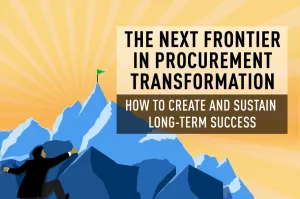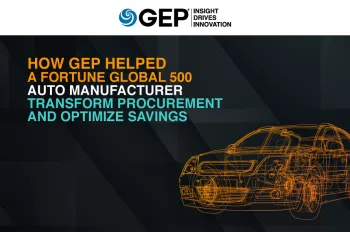Procurement transformation is a tried and tested method to develop a professional and high-performing procurement organization. Enterprises typically leverage the help of external consultants or other specialists to benchmark their starting position and develop a strategy, organizational model, policies and processes, as well as systems and capabilities to transform their procurement organization into a proactive, value-adding function. The business case for this effort usually is built on strategic sourcing — a robust way of delivering bottom-line savings that guarantees a solid return on investment to satisfy even the most skeptical of CFOs.
Many procurement organizations in market-leading enterprises across the world already have been through this type of transformation, and consistently are making meaningful financial contributions to the wider business. However, for a CPO leading such an organization, the new challenge becomes: What’s next? Continuous improvement, of course, is part of the answer — delivering somewhat more with somewhat less each year — but is procurement really just a one-trick pony and is there only one leap forward possible? Savings delivery, unquestionably, is the bedrock of any procurement organization –– but CPOs in mature procurement organizations should focus on the next leap forward, a second-generation procurement transformation.
Redefining Procurement’s Value Propositions
It often is said that procurement can deliver strategic advantage to an organization, but how many procurement organizations today define their value proposition as anything other than supply assurance and value for money? A good indication comes from the KPIs used. The maxim “what gets measured gets done” is germane here. While many procurement professionals preach “value, not just cost,” and focus on stakeholder management and business partnering, the vast majority still measure themselves only on savings, coverage, and a number of efficiency metrics. There is wide recognition that procurement can add value in many other ways, such as:
- Speed to market and innovation
- Risk management
- Quality management
- Supplier relationship management
- Sustainability
- Marketing effectiveness
However, procurement seems shy, almost reluctant, to fully take credit or measure its impact in these areas, creating a number of related challenges.
Not least among these is how to add these dimensions to organizations typically focused on sourcing. Some organizations attempt to deal with this problem by adding to the responsibilities of sourcing teams, others prefer to create specialist teams focused just on SRM, or sustainability, or risk.
In both cases, this usually is a case of layering something new onto an organization and processes designed for sourcing, rather than thinking about if and how the overall value proposition has changed, and how everything needs to be fully aligned to that value proposition (or propositions).
Here, we deliberately use value propositions in the plural, as many procurement leaders contend that while such value can be added, it just is not possible to measure it all in one consolidated figure. At GEP, we agree that it is not possible — nor is it desirable. Procurement needs to broaden its KPI set to encompass a much wider set of value propositions, and we believe that procurement transformation is the best way to achieve this.
Building The Business Case
A fundamental challenge in making significant changes to a procurement organization is building the business case for doing so, especially if current savings and cost of function metrics are reasonably strong. The starting point, nevertheless, still should be savings. By comparison with external benchmarks it is possible to quantify how much further savings delivery can be pushed and any procurement transformation, even if it’s a second-generation wave, should look to optimize this vital contribution of procurement to the organization’s financial health. The second wave of procurement transformation must go beyond strategic sourcing of key spend categories to deliver further value through the following levers:
- Demand and specification management
- Cost of function reduction (leveraging technology and low-cost countries)
- Tail-spend management (increasing spend managed by procurement)
However, to truly refocus the procurement organization on some of the value metrics other than savings and efficiency, procurement also needs to learn how to measure some of the other value contributions it is making. And this is a situation where one size definitely does not fit all. Below are some examples of different ways in which value can be quantified.
Speed To Market
Procurement can make a huge impact on a company’s success by making new product launches quicker and smoother, as well as cheaper. Imagine the positive impact for a major pharmaceutical firm if it could bring a new drug worth $1 billion in annual revenue into the market six months earlier. Why should the profits from that half year of additional sales not be considered a procurement value contribution? For sure, procurement can’t bring a new drug to market early on its own, but by leveraging its core skills of producing clear specifications, creating commercial agreements to incentivize suppliers for speed, even just by bringing alternative sources of supply into the mix, procurement can have a concrete impact on speed to market and should not be afraid to take credit for it.
Risk Management
Risk management is a board-level concern for all organizations and, in a world of extended and interconnected supply chains, third-party risk is a major challenge, one that procurement is in a prime position to influence. Although procurement organizations are typically very good at mitigating certain types of risk, through techniques such as establishing multiple sources of supply and inventory management, they usually do not have the knowledge or expertise to understand how the cost of risk is actually calculated. Total cost of risk calculations take into account retained losses and related loss adjustment costs, risk control costs, transfer costs and administrative costs. Applying this approach to third-party risk gives procurement a very concrete and well-established way to quantify its value contribution.
Sustainability
Sustainability is a great example of where value cannot be fully encompassed by a financial metric. In many cases, sustainable practices also can be financially beneficial (think of reducing packaging, for example). Unsustainable practices can hamper an organization’s reputation, and therefore its brand, quite substantially, but more to the point the value of doing the right thing and behaving in a responsible way is that it is the right thing to do.
There are several (non-financial) metrics that can help drive procurement’s performance in the right direction. For example, suppliers’ compliance to child labor regulations, CO2 impact of the supply chain, waste recycling, and so on. There also is an established range of specialist firms that can help track and measure such metrics.
In short, there are a range of value measures — some of which have been highlighted here — that procurement can use over and above the almost ubiquitous savings, coverage and efficiency metrics. However, the challenge is not just what to measure and how to measure it, but also how to fundamentally refocus a procurement organization on a broader set of value drivers.
Second-Generation Procurement Transformations
There are a number of reasons why a procurement transformation, as opposed to a process of continuous improvement, is necessary for an organization to add the types of value contribution and reach the levels of performance discussed in this paper.
The first is structural. Many firms already have had the experience of investing significant amounts of effort and resources in SRM programs, financial risk assessments, supplier code of conduct programs, etc. However, these feel, and tend to function, like bolt-ons to the main job of strategic sourcing. The metrics used tend to measure activity not impact (how many supplier performance evaluations were carried out, how many FRAs were executed, how many suppliers have signed up to the code of conduct?). This type of work is either given to a specialist team, which focuses just on that activity, or added to the workload of sourcing managers. However, as long as it remains ancillary to the sourcing process rather than an integral part of it, behaviors and outcomes will be suboptimal.
Let us illustrate this with an example: Is it better to launch an initiative with an existing supplier focused on enhanced innovation, or is it better to fully identify what you want from a supplier up front and then select that supplier based on those criteria? This is why a second-generation procurement transformation takes a holistic approach to all of the dimensions at play, and is superior to an approach based on continuous improvement.
The second relates to talent. As anyone who has been through a first wave of procurement transformation knows, change is uncomfortable. Even though these transformations have strong selling points to those impacted, such as buyers becoming strategically focused rather than tactically focused, experience shows that getting large groups of people to change the way they have done their job for a long period of time is neither quick nor simple, nor without some bumps along the road.
Once you start trying to build a procurement organization with specialist skills in risk management, supply chain, R&D, product life cycle management, contract management, and so on, it rapidly becomes apparent that the challenge is even greater. Indeed, a thorough procurement transformation will involve a carefully considered make vs buy process: Which skills need to be developed internally and which can more effectively be bought? Similarly, which processes need to be retained and which ones can more efficiently be outsourced?
The third consideration is speed. It should be apparent that we are not talking about small incremental changes here. Once your business case is built and the incremental value is clear, the imperative to start delivering on the promise should be strong. A procurement transformation focuses attention and resources on the overall goal and will deliver the future state model in a fraction of the time. Indeed, it is questionable whether many of the changes described here can be delivered at all without this level of focus.
So How Does A Second-Generation Procurement Transformation Program Work?
In terms of process, a second-generation transformation works exactly the same way as any procurement transformation, but in terms of content, the complexity and demands are significantly greater.

The first stage is a detailed diagnosis, understanding your starting position, areas of strength and weakness, and baselining performance.
In the second stage, the strategy is developed. This is where a second-generation transformation starts to distinguish itself. In first-generation procurement transformations, the goals (savings) and strategy are relatively straightforward. In a second-generation transformation, more effort are required to understand the true strategic objectives and the relative priorities of the procurement organization. A robust strategy development process starts with inputs from the entire C-suite, and is very closely aligned to the overall corporate strategy, not just the objectives of the CFO to reduce cost.
The output of a successful strategy development phase is a genuine, effective strategy with a clear statement of what outcomes are targeted and what choices are to be made, rather than just an aspirational vision statement.
In the third stage, the future operating model is designed, starting with the organizational structure, defining key interfaces with the rest of the business, addressing to-be processes, system and reporting requirements, performing a thorough make vs buy assessment, and writing job descriptions for key roles. A first-generation procurement transformation here is usually focused on rolling out pre-defined standard processes to a rightsized organizational blueprint, but in a second-generation transformation, this phase refocuses the existing processes on the different strategic imperatives defined and recreates the organizational structure anew, based on the priorities established during strategy development.
This is an area where a key innovation in recent years has been the decoupling of business partnering and sourcing activities within procurement departments to better prioritize non-savings related value contributions.
Finally, the fourth stage — the implementation itself — takes your organization through to the desired future state. Because this is not simply a case of training most of your people on strategic sourcing, this typically is considerably more complex than a first-generation transformation, and can take longer. A common feature of second-generation implementations is that they are multiyear projects with different aspects of the target operating model phased over time. As a key value driver of second-generation transformations frequently is agility, it could be argued that the target situation is never fully realized, since the ability to transform itself to meet the evolving requirements of procurement is of the essence for the top procurement organizations of the future.
Conclusion
Procurement transformation is a concerted effort to transform the focus and performance of a procurement organization, and many firms have successfully done this at least once. However, once maturity has been reached in savings delivery, the next step for procurement organizations to truly align themselves as strategic business partners within their enterprises is a big one that many struggle to make. In the ever ongoing quest to improve performance and to realize the full strategic potential of procurement, a second-generation procurement transformation allows leading organizations to radically rethink the way that procurement supports and enhances competitive advantage. Have you had yours?
Theme: Procurement



